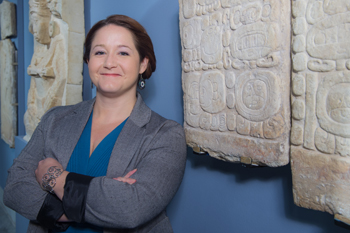Rice art history Ph.D. student opens window on long-vanished cultures
A new exhibition at the Museum of Fine Arts, Houston (MFAH) takes the visitor deep into the spiritual world of the ancient Americas, where animal deities ruled the heavens, Earth and underworld. “Fangs, Feathers and Fins: Sacred Creatures in Ancient American Art” was curated by Chelsea Dacus, an assistant curator at the MFAH who is currently in her first year of pursuing a Ph.D. in art history at Rice.

Chelsea Dacus, an assistant curator at the Museum of Fine Arts, Houston and Rice art history Ph.D. student, stands at the entrance to her "Fangs, Feathers and Fins: Sacred Creatures in Ancient American Art" exhibition. Photos by Jeff Fitlow
The exhibition, which opened Oct. 16 and will be on display through Jan. 25, draws from the museum’s significant pre-Columbian collection and spans nearly 5,000 years, Dacus said. It is the first time that the exhibitions’ nearly 200 artworks – dating from 3300 B.C. to 1550 A.D. – have been brought together thematically at the museum, she said.
“Since the dawn of time, humankind has been fascinated with the creatures that populate the world,” Dacus said. “In the Americas, wildlife such as the jaguar, harpy eagle and howler monkey became religious symbols of divinity and rulership, playing significant roles in religion and society. Artworks were made in the images of these beings to bestow supernatural powers, to protect and for worship. Other masterpieces were made to transform humans into other creatures or to show that transformation.”
Pre-Columbian peoples were particularly devoted to the concept of the world having three levels — celestial, terrestrial and underworld — and the role that animals played in that understanding as expressed by their representation in art, Dacus said.
Walking through the exhibition space on the lower level of the MFAH’s Audrey Jones Beck Building, the visitor’s eyes are drawn to the inventive ways animals are depicted, be it in a 1,000-year-old feather tunic from the Nasca people of Peru, the gold ornaments from the Tairona culture of Colombia or ceramic vessels and stone monuments made by the Maya and Olmec of ancient Guatemala and Mexico.

The exhibition's animal theme had a personal appeal for Dacus, who grew up collecting animal and wildlife pictures.
For Dacus, the exhibition’s theme had a personal appeal. “I’ve always been interested in animals. It’s been a passion of mine,” she said. “I never had posters of boy bands on my walls when I was a kid. I had pictures of animals. I subscribed to International Wildlife and would tear out pictures of animals and put them on my walls. It’s probably part of what drew me to pre-Columbian art because they have such an interrelationship with them. In the cosmological understanding of the world that they had, animals helped with different processes. The relationship was much more intricate; they’re not just animals to them.”
Dacus, who travels in between her full-time job at the MFAH and her classes on the Rice campus on her motor scooter, has found an ideal Rice faculty adviser in Assistant Professor of Art History and Classical Studies John Hopkins, who specializes in the antiquities. “Even though my first passion is pre-Columbian, I have always been drawn to ancient Roman art and with John there I thought it would be the perfect opportunity to research another area of interest while obtaining a degree from an excellent university and staying at the museum,” she said. “It was kismet.”
Hopkins said Dacus’ participation in his department’s Ph.D. program is a mark of excellence. “Chelsea’s leading role in the conception, curation and production of this exhibition marks a new stage in our nascent doctoral program,” Hopkins said. “The Ph.D. in art history at Rice is just six years old; our first cohort has not even graduated, and yet already we have a student who is a lead curator on an impressive, intellectually sophisticated and beautifully organized show at one of the country’s major encyclopedic museums.”
For more information about the “Fangs, Feathers and Fins” exhibition, visit www.mfah.org/exhibitions/fangs-feathers-and-fins-sacred-creatures-ancient-a.


Leave a Reply